Final report for FW16-030
Project Information
Poultry and egg production on Guam has been limited to backyard and small farm production. All larger production farms have shut down operations and have closed due to adverse weather, degradation of facilities and increased feed costs. Guam imports 95% of all its consumables. Fuel surcharges continue to increase, the result is an increase of those consumables. As the price of feed continues to rise it becomes increasingly difficult to operate a small poultry farm. Feed cost consist of well over 30% of farm cost.
Vegetable and fruit production are the larger percent of agriculture industry on Guam. The increase cost of material and supplies also influence horticulture farms. All fertilizers sprays and manures are all imported. Fertilizers are heavily used because of the lack of Nitrogen components in the islands soils.
This project was designed to combine poultry egg production and small scale vegetable production using a paddock style rotation. Moving poultry stock to new pasture at correct time intervals can reduce commercial feed input by open grazing and leaving manure residue resulting in minimum or no added fertilizers to soils. Problems with conventional poultry design to include high concentrations of manures resulting in ammonias and other gases unhealthy to the livestock and human counterparts.
Pullets being used for this project arrived Guam on August 12 2016. Three hundred were separated in two different brooders. At 1 month pullets were put on the ground. October new hen house completed. At 2.25 months pullets were separated into perspective locations. Total mortality rate to this point was at 15 percent. Preliminary Pasturing of hens began at 4 months. Observation of feed usage begins. Current age of Hens are at 5 months. Anticipation of egg production is at 6 months. Project will also conclude egg production quantity differences and product quality with two different practices. The next phase of this project will conclude outcomes and challenges and can educate the islands community on economic sustainability through proper production management.
Budget Expenditures to date, New Pullets $1095.00, Materials and Supply $2501.32. Commercial Feed $3211.50. Labor $600.00, Total $7502.82
1. Determine feed consumption and cleanup times to reduce feed input and maximize available pasture.
2.Establish and manage small scale vegetable crop production through use of livestock manure deposits and their ability to control pests while improving environmental and soil fertility conditions.
3.Showcase the importance of livestock production through pasture management decreasing the need and use of commercial feed.
4. Provide an easy step by step guide on efficient poultry and egg production for local farmers and producers through planned field survey days when egg production stabilizes.
Research
Impacts
Labor Hours-Through documenting both conventional and pastured poultry production, we have concluded there is a considerable more amount of labor hours involved with maintenance. This is due to manure concentration build up in the facility. It takes a minimum of 4 hours to remove soiled straw, replace with new material and clean ventilation screens . This needs to be done twice a month.
Feed Cleanup- Conventional vs Pastured, If hens are given fresh pasture it will take a considerable more amount of time for them to completely finish commercial feed rations. If pastured hens are not moved in a timely manner pasture time decreases and feed cleanup time can vary between the two systems. Usually matching one another. It is very important to follow a rotation schedule and to observe the activity of the hens.
Coconut- We have implemented the use of fresh split coconut in both locations. This helps with commercial feed costs and gives a healthy alternative of food stuff. Cleanup time varies with each location.
Accomplishments
* We were able to obtain larger brooders through the availability of discarded crates from a local renewable energy company. This lead to less stress and over crowding of pullets.
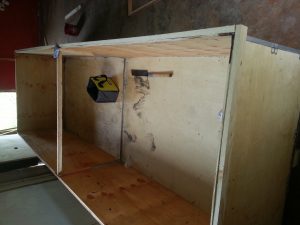 New Brooder
New Brooder 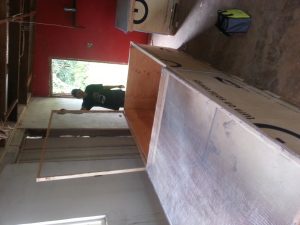 Brooding Stations
Brooding Stations
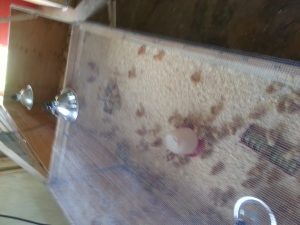
*October 2016 New hen house complete, designed with adverse weather in mind (typhoons). Steel pipe was used and roof brought closer to ground.
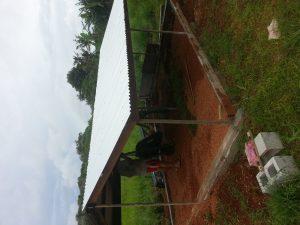 New Hen House
New Hen House 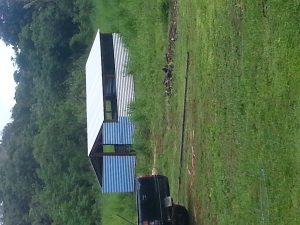 Complete House for pastured hens
Complete House for pastured hens
*November 2016, 4 month old pullets were put into a 2100 sqft pasture and left for a month to determine the amount of time it took to clear the paddock. This will give us a guideline on the correct time rotate into a new area and when they become more reliant on commercial grain. Result was area completely clear of available pasture within 2.5 weeks and crops could be planted at just 3 weeks. Visible manures spread across complete area.
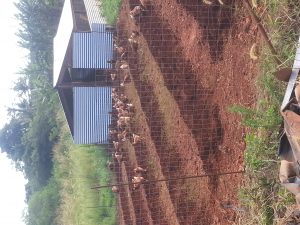 Preliminary results. 1 month
Preliminary results. 1 month 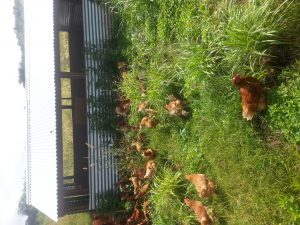 New pasture rotation
New pasture rotation
*Through documentation of commercial feed given. Dec 2016 and Jan 2017, Morning feedings of commercial feed and open to new pasture. A large portion of the hens preferred moving to new paddock with fresh pasture eventually cleaning feeders later in the day or not cleaning them at all. Ten pounds of feed is given three times a day at 30 lbs max as ration. If there is still existing feed, feeders are topped off. Proving the ability to reduce commercial feed.
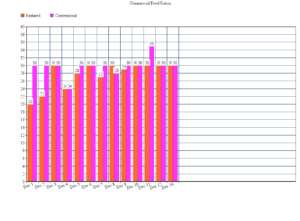 Feed variation
Feed variation
Research Outcomes
Education and Outreach
Participation Summary:
During the last quarter of project we held two farm visits. We introduced and toured both the rotating paddock and conventional housing methods. First visit we had Dr. Theodore Radovich from the University of Hawaii and Mr. Frank Cruz from University of Guam extension and outreach. The second visit was with Hauhouot Diambra- Dr. Odi from the University of Guam and his students from Class:AL 211 Lecture and Lab. Class: AL 211was a workshop for AG students in the field Animal Science . We would love to call them future farmers of the islands. All participants were educated in both hen housing scenario's.
Both visits and discussions were informative for all participants. Dr. Radovich and Dr. Odi both left with new ideas for future projects and Paradise Natural Farm gained new information on alternative feed formulas from Dr. Odi and a description of animal impact on soils from Dr. Radovich and Cruz. Students gained knowledge on sustainable egg production at a lower operating cost. Those originating from Micronesia's smaller outlying islands benefited greatly from visit and left with new information and techniques to bring back to their island homes.
Paradise Natural Farm will continue to work with Dr. Odi in future projects. Paradise Natural Farm continues to give individual and family tours to interested parties and our valued customers and their children. Paradise Natural Farm has been invited to speak and give a presentation on our ideas and progress of livestock grazing rotation set for the month of February. 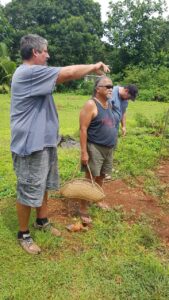
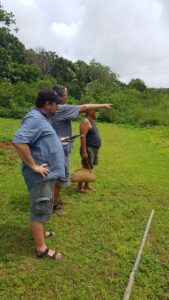
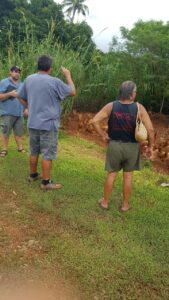
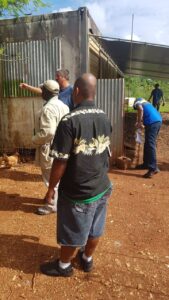
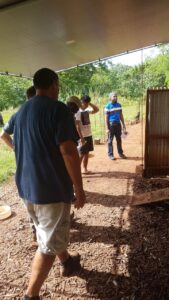
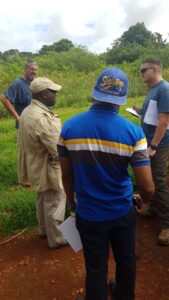
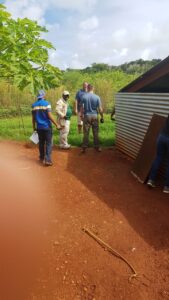
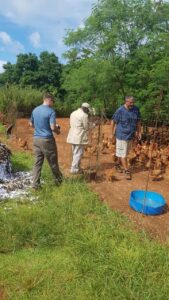
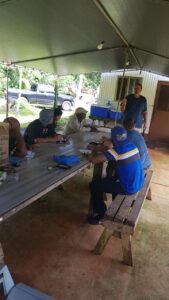
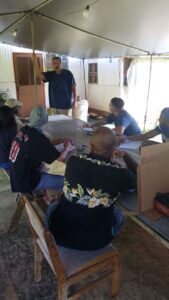
Education and Outreach Outcomes
Total assessment of project is a success. The key factor of the project as a whole is feed cost. Commercial feed is to expensive to make a profit and keep a livestock farm operational. Other means of feed for our hens are what keep us going. Pasture rotation is key. Chickens at omnivore by nature and grasses can make up to 15% of food stuff. another 20-25% of feed can come from fruit and vegetable crop residue. The second year of project we put papaya, mulberry and peanut butter plums in place within system as a alternative feed and gather our own crop residue(pepper, eggplant, banana and coconut). A 40% in commercial feed saving is possible. Hen house manure are added to all crops. Shredded paper supplied and delivered for free cut our cost on straw bails @$50.00 a bail. One bail per location every two months totals $600.00 a year.
The one component that we would change is the size and area of paddocks. Roughly 2000 tri. sq. Ft. is not enough room for 150 head of hens. Through time areas can become decimated and barren during the drier season thus the need for higher commercial feed input and or watering of area to promote natural growth. We have decided alternative food stuff will come from off site vendors, markets and restaurants all helping with dry season and overall food consumption. all of these will decrease the need for commercial feed and detrimental of a small poultry farm on a tropical island in the Pacific. These ideas can be reproduced anywhere in our region as vegetation growth is renewable at a faster pace in a tropical environment.
Feed rations and suppliment- using paddock rotation system utilizing grass and overgrowth. implementing veg and fruit crop residue.
Soil enhanecment through livestock rotaion and manure residue.
Hen house carbon and manure- utilizing carbon mass and chicken manure for vegatable and fruit production
Product quality- Egg quality is increased with alternative feed and pasture. Quality is outstanding, customer feedback
Labor- Labor is decreased with ranged hens manure build up in facilities is less with a pastured flock.
Soil impact- The movement of live stock is important to prevent soil compaction.